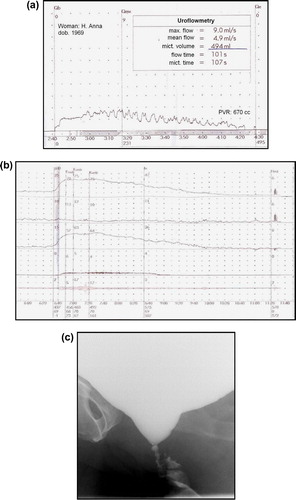Figures & data
Table 1 The causes of female VD.
Figure 1 Results from a 44-year-old woman who underwent several urethrotomies and urethroplasty, and presented with severe voiding symptoms and a high PVR: (a) Uroflowmetry showed a prolonged fluctuating pattern with a decreased Qmax and a PVR of 670 mL. (b) The PFS showed a high PdetQmax of 64 cm H2O and a low Qmax of 4 mL/s. (c) VCUG showed a closed bladder neck due to functional and anatomical reasons.

Figure 2 A urodynamic study of a 91-year-old woman with mixed urgency and stress continence. (a) The urodynamic curves show DO with weak detrusor contractions, accompanied by increased EMG activity (she tries to hold on voluntarily when urgency occurs), at maximum cystometric bladder capacity only a minor increase of detrusor pressure, and voiding by abdominal straining. (b) On blocking the bladder neck with the inflated balloon of the urodynamic catheter, there is a good detrusor contraction with a detrusor pressure amplitude of 50 cm H2O, indicating that with increased outlet resistance (e.g. after sling implantation), a detrusor contraction can occur.

